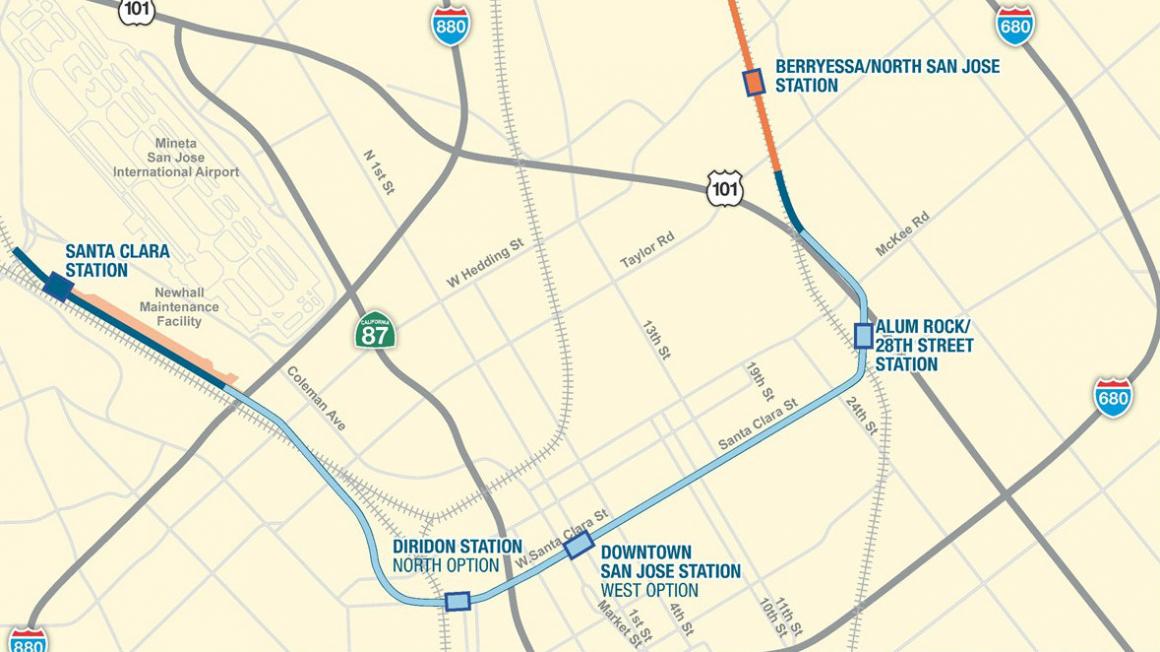In a unanimous vote Thursday evening, April 5, VTA Board members approved the staff recommendation for VTA’s BART Silicon Valley Phase II Extension Project.
The Board approved a single-bore tunneling methodology for the 5-mile subway through downtown San Jose. The two station options approved include Downtown San Jose West (between Market and Fourth Streets in downtown San Jose) and Diridon Station North (adjacent to the south side of West Santa Clara Street, between Autumn Street and the San Jose Diridon Caltrain Station.)
The Board also certified that the Subsequent Environmental Impact Report (SEIR) for Phase II meets the requirements of the California Environmental Quality Act (CEQA).
“Today’s certification of the BART Phase II EIR represents a key milestone in our decades-long effort to bring BART all the way to Downtown San Jose and Santa Clara,” said San Jose Mayor Sam Liccardo, who serves as Chairperson of the VTA Board of Directors. “We would not have gotten here without the leadership of Nuria Fernandez and Grace Crunican, as well as the hard work and steadfast determination of so many on their teams.”
VTA’s BART Phase II Project is the largest transportation infrastructure improvement in Santa Clara County history. The new commute option is anticipated to take tens of thousands of cars off the roadways, connect employees to jobs, and provide continuous rapid rail service around the San Francisco Bay Area.
Why a single-bore tunnel?
VTA is responsible for delivering the safest, least disruptive project for the next six miles of BART Silicon Valley into downtown San Jose and Santa Clara – a project that meets both the needs of the operator (BART) and expectations of community stakeholders, and is prudent of taxpayers’ dollars.
The single-bore design meets industry and BART facility standards for operations and safety, and would reduce impacts to street level activities and underground utilities that would occur with twin-bore construction. More specifically, the single-bore tunneling methodology, compared to the twin-bore option, will:
- Result in limited excavation within the public street right-of-way, resulting in less construction impacts to businesses and the community during construction;
- Reduce impacts to auto traffic, bicyclists, and pedestrians because it would not require the closure of Santa Clara Street and adjacent roadways during construction;
- Eliminate impacts to VTA’s light rail service because the tracks crossing Santa Clara Street at 1st and 2nd streets would not have to be temporarily closed due to street-level excavation while constructing the downtown subway station; and
- Provide greater operational flexibility, allowing for the ability to provide multiple crossover tracks and areas to store train cars within the tunnel for emergencies, special events, or regular maintenance activities.
Getting to consensus
Exhaustive efforts have been made since the conclusion of the November 2017 Peer Agency Review to aid in VTA staff’s recommendation on the tunneling methodology, including multiple technical forums and workshops (in January and February 2018) between VTA, BART and industry experts on the single and twin-bore tunnel options.
FTA granted VTA a three-month extension in January to complete the project development phase of the Federal New Starts funding program, which provided staff the opportunity to continue to work with BART and to respond to BART’s comments relating to operational and safety procedures.
We are confident that most of BART’s comments throughout this comprehensive process have been addressed or otherwise deemed as operating preferences.
Next steps
On April 26, the BART Board of Directors will be asked to vote on the project description in the SEIR. The next milestone to be reached is the Record of Decision which is anticipated from the Federal Transit Administration (FTA) in early June 2018.
As VTA and BART begin to embark on this critical transportation infrastructure project, a comprehensive and well-coordinated effort will be made to engage and communicate with project stakeholders and communities located along the corridor during all phases of the project.
VTA’s community engagement team will work closely with residents and businesses that may be impacted by construction, anticipated to begin in 2019 through 2026. Members of the public can sign up for upcoming news, notifications, and project information in general at www.vta.org/phase2info.
